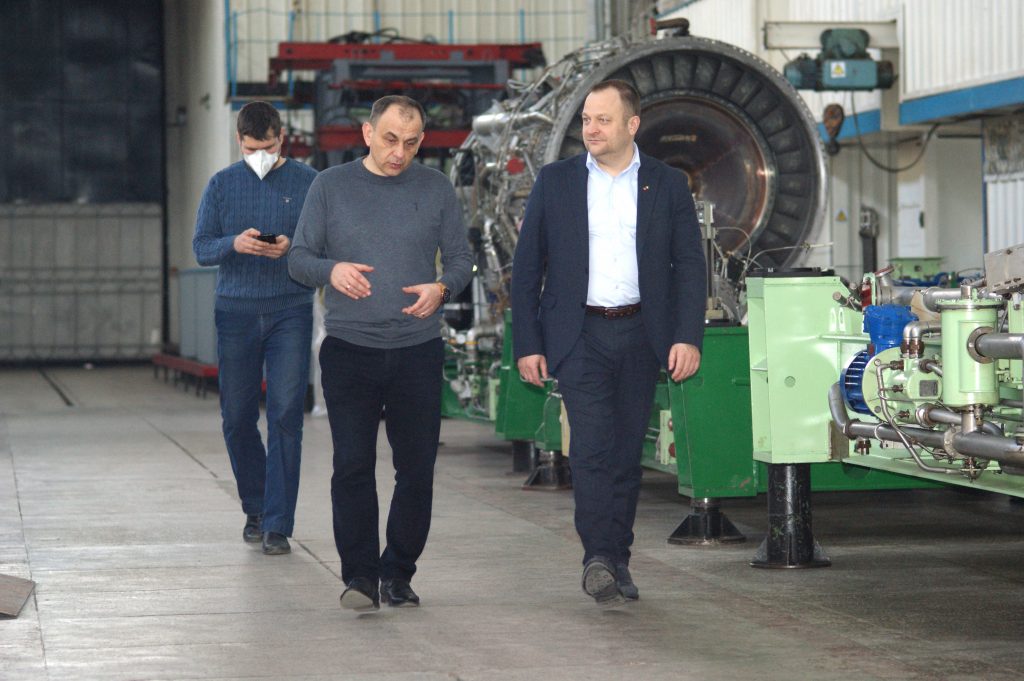Denys Gordiyenko: Today gas turbine power plants is practically the only way of creating highly efficient units for mobile power industry
The world is continuously moving to carbon-neutral future. More and more attention is being drawn to innovative projects that use hydrogen. The Energy Club interlocutor within the framework of “Big interview” is Denys Gordiyenko, General Director of SE GTRPC “Zorya”-“Mashproekt”. We are talking about world trends of development and problems in Ukrainian power industry, about relevance of gas turbine technologies. We also want to know what challenges the enterprise faces and how Ukrainian developer engages young people in complicated technical work.
— Mr. Gordiyenko, discussions of the country’s energy prospects in the present-day Ukrainian information realm are mostly concentrated on the matters of green power engineering, tariffs, the problems of coal industry, nuclear power plants… But gas turbine technologies and projects are virtually left out in these discussions. How relevant are they for the modern power industry considering, among other things, the urge to give up carbon?
— The present-day gas turbine technologies are one of the most efficient solutions for numerous challenges of the world power industry. This is confirmed by global implementation of such power projects.
However the range of problems solved by these projects is quite wide: from power supply of installations located far from infrastructure, oil and gas fields to covering peak loads in urban power networks.
The technology itself is variable from the viewpoint of using different types of fuel. Natural gas, rare types of fuel, industrial and even household waste may be the raw material for synthetic fuel. However modern gas turbine engines maintain ecological parameters at a very high level.
And the present-day trend is usage of hydrogen. This is a leading topic of gas turbine equipment designers all over the world if we are talking of switching to carbon-neutral power engineering. To be honest, though, the world will not be able to completely give up fossil fuel like natural gas for a long time to come.
— The lack of mobile capacities is a sensitive issue for Ukraine. To what extent may gas turbine power plants be the technology to be chosen for constructing mobile power plants?
— The lack of mobile capacities is now the main problem of Ukrainian power industry. At present gas turbine power plants (GTPPs) is the only way of creating highly efficient units for mobile power industry. Short period of startup and reaching nominal power as well as high ecological and technical characteristics are main criteria for units for mobile power industry. Besides, gas turbine power plants are compact – their dimensions are not large which enables to locate them in the existing infrastructure. Such GTPPs require relatively small investments. This is a fast, efficient and reliable solution of mobile capacities problem, it has no alternative in a certain range of capacities. We are already able to supply such power plants to cover peak loads.
— Does “Zorya”-“Mashproekt” have ready solutions updated for realities of our power network?
— Our offer is quite big. To the domestic customer our enterprise offers, first of all, highly reliable and efficient equipment field-proven in various projects — complete power plant units with unit output of 5-6, 16 and 25 MW for power plant of simple, co-generation and combined cycle. The units have high factory readiness. This is a good offer not only to cover peak loads but also for basic generation of certain power and for mobile power plants 5-25 MW in power.
As for creating mobile capacities on the basis of gas turbine technologies, Ukraine has a specific resource: a number of gas-pumping stations of cross-country gas pipelines that lost their relevance for various reasons. These installations have ready infrastructure and trained personnel. This is an excellent basis for building mobile gas turbine power plants but this is also a promising resource for developing gas-hydrogen technologies.
— Today the world regards hydrogen as a most progressive direction. Ukraine also makes some progress in this sphere as well. Mr. Gordiyenko, what development potential for the issue in our country do you see?
— Most talk in Ukraine is about producing hydrogen and transporting it to European consumers with the help of the existing gas transmission system. But the compressor stations I have mentioned may be used as a basis for gas-hydrogen-fueled power plants. Creating pilot projects at the existing installations, their experimental testing and obtaining industrial prototypes ready for operation may right now give Ukraine priority in the sphere of implementing gas-hydrogen and hydrogen technologies as the source of obtaining industrial electric energy.
Using hydrogen for adding it to natural gas in cross-country gas pipelines, at the 1st stage it may be 20-40%, will enable within a short period, on the one hand, to decrease toxic emissions and, on the other hand, to create highly efficient power industry. Such step may be very important for Ukraine due to excessive amount of fundamental capacities available. Producing hydrogen, adding it to the existing gas transmission networks may become a most important export item. This stage may be accomplished as early as 2024-2025. At the second stage the switch to using pure hydrogen fuel. By our experts’ estimates this may happen around 2030-2035.
We already have long-term experience of our gas turbine engine working on the fuel with high hydrogen content. At present we are actively working at creating a test rig which will enable us to finish combustion chambers of all range of our GTEs that use gas-hydrogen and hydrogen fuel. We plan to put such test rig in operation in the mid-2022. This is only a first step. The next one is testing our hydrogen fuel GTE and the pilot project.
We would be most interested in the pilot project on the basis of our new gas turbine engine 32 MW in power which already has technical characteristics matching those of leading foreign equivalents.
— Getting back to the problems of mobile capacities, do you know the Ministry’s position as to the choice of technology concepts?
— We have been waiting quite a long time for inviting tenders for mobile capacities construction. As of today we cannot say for sure what sort of technology concepts the Ministry prefer. But we can say for sure that the Ministry of Energy is looking for suppliers-investors. Such approach creates serious obstacles for our company. Today ZM supplies high-quality solutions, including integrated ones, for various tasks but the company is not ready to invest.
The Ministry’s position is understandable but in fact it elbows out the domestic designer and manufacturer. It may result in certain consequences like insufficient operational efficiency or high maintenance price. In general, from the perspective of the country’s energy security, dependence from foreign suppliers is definitely a negative factor.
— Today Ukraine remains the country that widely uses coal generation. In this field we act so far in opposition to the world trend of giving up coal. May gas turbine construction offer an efficient alternative?
— The problem of old coal and heat-and-power stations does exist in Ukraine. Their ecological characteristics are beneath criticism. The technical characteristics are substantially inferior to alternative technologies. At the same time it would be quite difficult to give them up completely in the near future. On the one hand, replacing them with an alternative requires substantial investments, on the other hand, their functions are not limited to power generation only. It is also supplying heat to the cities. As a consequence, the problem is of integrated nature and it cannot be solved, for example, by green energy only.
Considering the situation, we have two options. On the one hand, the use of gas turbine technologies may considerably increase the existing facilities’ efficiency. I am talking about creating “gas turbine superstructures” affiliated with them where gas turbine engine is used as air blower into the existing boiler thus increasing efficiency of the unit as a whole. Such solution may be used both for big power plant units and for small municipal heat-and-power stations.
If we are talking about full-scale alternative the world experience demonstrates that gas turbine technologies play a key role in giving up “dirty” coal generation. Combine cycle gas turbine power plants are used as a replacement which enables to solve not only the problem of power supply, but also the problem of heat supply. Such power plants are substantially more energy and ecologically efficient.
— Over 95 percent of solid municipal waste in Ukraine are removed to landfill sites. But the wastes may be an energy source. How feasible the use of gas turbine equipment for waste disposal and power generation may be?
— Various technologies of converting waste to energy, the so-called W2E projects, have long since been developed and used in the world. Part of such projects use gas turbine technologies. We are talking about various kinds of synthetic fuel from waste and garbage to be further used in gas turbine units. This approach is more than justified as only gas turbine engines can most effectively burn the fuel that has quite wide spread of characteristics.
As far as I know, there are no such sort of gas turbine projects in Ukraine so far but the interest for the subject is growing. At present our company negotiates with an interested party — a domestic customer. However the global experience demonstrates that local small-power and medium-power gas turbine power plants that operate on such fuel and provide electricity and heat to small communities or big cities districts may be most efficient. So this is the efficient solution for this long-standing problem.
— SE GTRPC “Zorya”-“Mashproekt” is a world-renowned designer and manufacturer of gas turbines and gas turbine units of marine and general-purpose application. What is the export share in the enterprise’s total scope of supply? What is it due to? What foreign markets do you cooperate with? What are the biggest partners among foreign countries?
— Throughout the whole 30-year history of modern independent Ukraine the export share in our enterprise’s total scope of supply was no less than 90-95 percent. And so far this trend shows no change. But in the last years we quite successfully take part in tenders of Gas Transmission System Operator of Ukraine. These are the gas pumping units reconstruction projects with gas turbine engines replacement as well as substantial amount of overhauls. We still have a sphere of activity at the Ukrainian GTS so we plan to continue our cooperation with the GTSOU. The enterprise has great experience in implementing projects of modernization and new construction in gas transportation sphere in various regions and climatic zones but its major share relates to purely foreign projects.
As for the Navy, the only gas turbine ship of the Ukrainian Navy is its flagship – frigate “Hetman Sahaidachny”. Of course, we participate in the projects of the ship repair and modernization but so far this is what our today’s contribution to the national Navy is limited to. A while back the enterprise was selected the designer and supplier of marine power plant for corvette “Volodymyr Velyky” [“Vladimir the Great”] and the class of ships after this project but its fate is still uncertain. So far there are proposals as to upgrading this project, but no decisions have been made yet. It may be replaced by a more advanced corvette project but the question is whether Ukraine will build the ships itself or buy them elsewhere. So far Ukraine is not developing its own gas turbine fleet, thus in this sphere we almost entirely work on foreign markets supplying equipment to the Navies of the South and South-East Asia countries where ambitious programs of renovation and development of the Navies are carried out.
The situation in the domestic power industry is similar to a certain extent if we are talking of the public sector and strategic issues such as providing mobile capacities. But efficiently work at solving local tasks. A series of power projects on the basis of our equipment have been implemented in Ukraine. There are basic generation projects, including the ones using co-generation, that supply communities with electric and heating energy. There are several projects of purely industrial purpose. However most big and significant ones have also been carried out abroad – mainly in the Near East countries. We have experience in operating in Canada, the countries of Eastern Europe, Middle Asia, West Africa. By the way, it is in the African continent where both our competitors and we see most astounding prospects for power projects.
— What challenges is the enterprise facing? What are the research work directions and development plans? Tell us about research and innovation activity of the enterprise.
— From the moment of its creation the enterprise was aimed at designing new gas turbine equipment. The enterprise comprises design department, research and development department and trial production. We have our own test rigs for real tests of all our products. Thus we can design new equipment specimens, quickly manufacture experimental equipment, both separate units and the whole engine, carry out the necessary specific research. The enterprise has a good development base. This is our strength.
As for activities directions, there is a large amount of constant work – the one of improving our engines’ technical characteristic, including ecological characteristics. This is a wide-range work and it never stops.
There are strategic tasks – creating a new engine: a basic one, that is the one that nay be used in various directions of our activity, or specific one, for example, for power industry.
And there is work on innovation directions. We have already mentioned the prospects of hydrogen. Now it is one of the most relevant topics for us. Another issue is adapting our equipment for the purposes of waste recovery. Both directions are much in demand on the market and relevance will only increase.
If we are talking about purely power industry direction, we are working at creating quick-assembly modular container power plants, including mobile ones, i.e. such that may be used temporarily until permanent infrastructure is created and then moved to another location. We are planning to come in the market very soon with such integrated solution which we will be able to implement very quickly with due regard to the consumer’s needs.
— Mr. Gordiyenko, what makes the enterprise a success? How many employees work there? What do you do to preserve the team? Do you have motivation programs or special education and trainings, and so on?
— Gas turbine construction is a complicated industry both from the point of view of product designing and from the point of view of manufacturing, further technical support, business processes. Successful work in the industry is closely connected with skills, education level, experience of the specialists who work there.
Every year about 3,000 our employees take classes, seminars, trainings, improve their skills. We invite leading experts, well-known business coaches. On our own efforts we can train people in about 120 working trades, we have the respective certificate. There are special programs for young specialists’ adaptation, for motivating proactive employees.
We offer capacious benefits package. We have our own clinic with day patient department and physical therapy. There are six canteens with high-quality meals and friendly pricing policy. We provide the employees with places in our kindergartens. Three recreational compounds and a children’s camp work every summer.
At present the most important thing for us is providing continuous use of production capacities, letting people work in their specialties and get a decent wages.
Our staff is quite large – about 8,500 employees but their average age is about 50, so today we face a serious challenge – attracting talented young people to study and work in complicated technical fields, their adaptation in the industry and further retention in the company.



